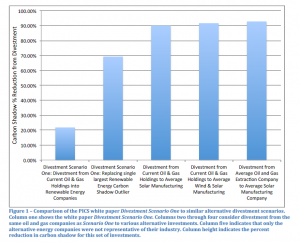February 27, 2015
George Hoberg*
A White Paper released by the Pacific Institute for Climate Solutions last month argues that fossil fuel divestment campaigns are based on a set of unfounded assumptions. The authors, Hadi Dowlatabadi and Justin Ritchie of UBC, make some valuable contributions to the debate over divestment. But their criticisms of the divestment advocates’ core arguments are off-base.
The PICS paper makes two important contributions to the debate. The authors provide a series of recommendations about policies and financing that can provide effective support to the divestment movement. Second, the authors emphasize the challenge, frequently lost in the divestment dialogue, that a very high fraction of the world’s fossil fuel reserves are owned by governments and not traded in financial markets, and therefore relatively immune to pressure tactics focusing on financial markets.
But the paper’s challenges to the core assumptions of the divestment movement are unfounded, both because they are not addressing the actual theory of change guiding the fossil fuel divestment movement, and because their methodology, and the way they applied it, does not actually allow them to effectively measure what they are trying to analyze.
First and most important, the PICS paper attempts to examine the direct impacts of divestment, either on the greenhouse gas emissions associated with portfolios, or on directly reducing carbon pollution because divestment “will keep fossil fuels in the ground.” This is not an accurate representation of the theory of change underlying the divestment movement. As our colleagues at the University of Victoria have highlighted already in response to this study, “The divestment movement’s primary goal is to challenge the social license to operate oil companies enjoy, making it harder for them to successfully lobby against needed government action.” (For similar responses to the PICS study, see here, and here.) An influential report from Oxford University argues: “The outcome of the stigmatisation process, which the fossil fuel divestment campaign has now triggered, poses the most far-reaching threat to fossil fuel companies and the vast energy value chain. Any direct impacts pale in comparison.” The same study, which also looked at past divestment efforts, found that “in every case [they] reviewed, divestment campaigns were successful in lobbying for restrictive legislation.”
Second, the PICS report analysis of the more direct impacts of divestment is based on a methodology that does not effectively measure what the authors are trying to analyze. A new critique posted on the PICS website takes the PICS report to task for several methodological and analytical problems. The authors of the PICS report develop a methodology called the “shadow impact calculator” designed to show the “carbon shadow” of investments. The shadow impact calculator relies on an input-output model using historic greenhouse gas (GHG) emissions intensities and single-year snapshots of the economy. As a result, it is just not particularly useful in illuminating the future carbon footprint impacts of changing investment decisions, which is exactly what the climate-focused investors are trying to do.
Finally, the way the authors applied their method to a sample university portfolio (UBC’s) dramatically underestimates the carbon impact of divestment. Their analysis substituted the six fossil fuel companies in which UBC has direct holdings for a sample of six renewable energy firms. They come up with the surprising result that the carbon shadow of that investment shift is only reduced by 22%. Their sample of renewable firms was selected randomly, but the six they ended up with had a major outlier in it which led, unintentionally, to a terribly unrepresentative sample. As shown in the figure, a re-analysis using the average carbon shadow of renewable companies – a more representative approach – reveals a much larger 90% reduction in the carbon shadow.
The PICS White Paper is off-base for two reasons. First, it does not address the theory of change actually guiding the fossil fuel divestment. Second, a more careful analysis shows that the direct impacts of divestment on the carbon shadow of investments can be much higher they find.
_____________________________________________
*Double disclosure statement: As any reader of this blog would likely know, the author is the faculty coordinator of UBCC350, the group leading the divestment campaign at UBC. The author also received research funding from PICS on forest carbon policy.

